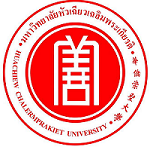Please use this identifier to cite or link to this item:
https://has.hcu.ac.th/jspui/handle/123456789/677| Title: | 古龙《大人物》两种泰译本的翻译手法比较 |
| Other Titles: | การศึกษาเปรียบเทียบวิธีการแปลนิยายจีนกำลังภายในเรื่อง "ต้าเหยินอู้" ของโกวเล้ง ฉบับภาษาไทย Comparison Study of Translation Techniques Applied in Chinese Martial Arts Novel "The Big Shot" by Gow Leng (Thai Version) |
| Authors: | 王建设 หวัง, เจี้ยนเซ่อ Wang, Jianshe 黃珍珍 สุจินดา แซ่อึ้ง Huachiew Chalermprakiet University. College of Chinese Studies |
| Keywords: | โกวเล้ง Gow Leng นวนิยายจีน -- การแปลเป็นภาษาไทย 武侠小说 -- 泰语翻译 Chinese fiction -- Translating into Thai การวิเคราะห์เนื้อหา Content analysis (Communication) 内容分析 ต้าเหยินอู้ (นวนิยาย) 内容分析 古龙 |
| Issue Date: | 2009 |
| Publisher: | Huachiew Chalermprakiet University |
| Abstract: | 随着中泰文化交流的不断加强,中国武侠小说作为文化传播的一种方式,被大量地引进到泰国。武侠小说的翻译也成为翻译园地中愈来愈重要的领域。作为原语言和译语言的媒介,译者在翻译中的作用至关重要;不同的译者会有不同的译作,文学作品的翻译也不例外。本文就古龙所著武侠小说《大人物》的两种泰译本 “ผู้ยิ่งใหญ่”(普英艾)和“เทพบุตรยุทธจักร”(贴帕卜如塔札)的翻译手法进行比较,分析二者的异同得失。分析结果,二者的相同之处是:一、采取直译、意译和音译混合法;二、适时加注。二者的不同之处是:一、直译时,前者过于拘泥原文,后者则比较灵活;二、前者的意译有过于随意之嫌,后者则较为认真,不肯苟且;三、音译时,前者采用潮语音译,后者采用汉语音译;四、语言方面前者比较粗俗,后者较为文雅。笔者认为,在翻译武侠小说时,翻译的“信、达、雅”三项原则中,以“信”(忠实)最为重要,“达”(通顺)则次之。极端的直译和意译均不可取,二者应相辅相成,互相补充。至于音译,本国至今没有统一规范的翻译规范,所以译者最好还是采用汉语音译,在音译后面还要加注原文,以免误解,尤其是在将其还原时,才不会遇到无所适从的尴尬局面。 ประเทศไทยและประเทศจีนมีการแลกเปลี่ยนวัฒนธรรมกันอย่างต่อเนื่อง นิยายจีนกำลังภายในจัดเป็นการเผยแพร่วัฒนธรรมประเภทหนึ่งที่ได้รับความสนใจจากนักอ่านจนมีการนำนิยายประเภทนี้เข้ามาในประเทศไทยอย่างมากมาย ดังนั้น การแปลนิยายจีนกำลังภายในจึงนับวันจะมีส่วนสำคัญและได้รับความสนใจในแวดวงงานแปล งานแปลนิยายจีนกำลังภายในเป็นการถ่ายทอดระหว่างภาษาต้นทาง (ภาษาจีน) กับภาษาปลายทาง (ภาษาไทย) ผู้แปลมีส่วนสำคัญต่อการแปลเป็นอย่างยิ่ง ผู้แปลที่ต่างกันย่อมมีผลงานแปลต่างกัน ผลงานการแปลวรรณกรรมก็เช่นเดียวกันวิทยานิพนธ์ฉบับนี้เป็นการเปรียบเทียบวิธีการแปลนิยายจีนกำลังภายในของโกว เล้ง เรื่อง《大人物》(ต้า เหยิน อู้ ) ฉบับภาษาไทยทั้งสองเล่ม คือ “ผู้ยิ่งใหญ่” ของ ว. ณ เมืองลุง และ“เทพบุตรยุทธจักร” ของ กิตติพิรุณ และวิเคราะห์การแปลส่วนที่คล้ายคลึงกันและแตกต่างกันรวมถึงข้อดีและข้อด้อยของงานแปลทั้งสองเล่มผลของการวิเคราะห์ส่วนที่คล้ายคลึงกันของงานแปลวรรณกรรมทั้งสองคือ1.ใช้วิธีการแปลแบบผสม คือ มีทั้งการแปลแบบตรงตัว การแปลแบบถ่ายทอดความหมายและ การแปลแบบทับเสียงคำศัพท์2.ใช้วิธีอรรถาธิบายขยายความเพิ่มเติมได้อย่างเหมาะสมข้อแตกต่างของงานแปลวรรณกรรมทั้งสองคือ1.วิธีการแปลประเภทแปลแบบตรงตัว พบว่า ว. ณ เมืองลุง คำนึงถึงภาษาเดิมเกินไป ขณะที่กิตติพิรุณได้มีการพลิกแพลงเทคนิคการแปล2.ประเภทการแปลแบบถ่ายทอดความหมาย พบว่า ว. ณ เมืองลุงแปลแบบตามถนัดและความเคยชิน ขณะที่กิตติพิรุณค่อนข้างเอาใจใส่ต่อการเลือกสรรถ้อยคำการแปล3.การแปลแบบทับเสียงคำศัพท์ พบว่า ว. ณ เมืองลุง แปลด้วยภาษาจีนแต้จิ๋ว ขณะที่กิตติพิรุณแปลด้วยภาษาจีนกลาง4.ด้านการใช้ภาษา พบว่า ว. ณ เมืองลุงใช้ภาษาสามัญธรรมดาแบบชาวบ้านทั่วไป ขณะที่กิตติพิรุณใช้ภาษาค่อนข้างสุภาพผู้เขียนมีความเห็นว่า การแปลนิยายจีนกำ ลังภายในนั้น ในหลักการแปล “ 信(faithfulness)、达(expressiveness)、雅(gracefulness)”ทั้งสามนี้ “信” สำคัญที่สุด“达” รองลงมา วิธีการแปล “การแปลแบบตรง” กับ “การแปลแบบถ่ายทอดความหมาย” อย่างสุดโต่งนั้นล้วนไม่ควรปฏิบัติ ควรนำหลักวิธีการแปลทั้ง 2 แบบมาใช้ประกอบเสริมซึ่งกันและกันส่วนการแปลทับศัพท์ภาษาจีน ทุกวันนี้ในบ้านเรายังไม่มีแบบอย่างการแปลที่เป็นมาตรฐาน ดังนั้นผู้แปลควรใช้การแปลทับศัพท์ด้วยภาษาจีนกลางพร้อมทั้งคงภาษาเดิมไว้ในวงเล็บเพื่อไม่ให้เกิดการผิดพลาดและเข้าใจผิด โดย เฉพาะเมื่อแปลกลับเป็นภาษาเดิมนั้น จะได้รวดเร็วและถูกต้องสมบูรณ์ As we know Thailand and China have had a long history of cultural exchangecontinued until today. Chinese martial arts novel is one source of learning Chineseculture. Therefore,we have seen a large number of these novels imported intoThailand. The influx of Chinese martial arts novels has resulted in the business ofChinese - Thai translation which has now become more and more important in“Column”. The fact that these novels reflect a link between the original Chineselanguage and the translated Thai language, the translator plays a very important role.Different translators will translate the same work differently. The same holds true forthe translated works of literature.This thesis presents a comparison of translated Chinese martial arts novels fromthe original book, “Ta Yuen Ou” by Gow Leng. The Thai translation was done for 2novels, “ผู้ยิ่งใหญ่” of W. Na Muang Lung, and “เทพบุตรยุทธจักร” of Kittipiroon. Thecomparison is made in many aspects including translation techniques, analysis of theparts where translation is the same and those that are different, and the advantages anddisadvantages of each technique.Based on the comparison, the following similarities are observed:1. Both translators use a combined technique which includes direct translation,meaning interpretation, and quotation of the original wording.2. Both translators use appropriate additional explanation to enhanceunderstanding.The followings are the differences in techniques observed from the twotranslators:1. When using direct translation technique, the first translator tends to be usingmore of the original wording while the second one is more creative.2. The first translator uses meaning interpretation method at his own leisure inthe way he is familiar with whilst the second translator is more attentive and morecareful3. The first translator uses a dialect (Tae Chiew แต้จิ๋ว) when making a directquotation of the wording whilst the second translator uses Mandarin expression.4. The first translator tends to use a casual layman language. The secondtranslator picks a more polite wording.Based on the comparison, we observe 3 main rules in the translation of Chinesemartial arts novels which include“信 (faithfulness), 达(expressiveness)and 雅( gracefulness ) ”. “ 信” (faithfulness) is the most important among all thetranslation principles. Next is “达” expressiveness.It should be noted that the techniqueof “direct translation” and “meaning interpretation” should not be used in the extreme.Both techniques should be adopted to complement each other where appropriate. Fordirect quotation of original wording, there is no formal or standard translationtechnique for such. Therefore, the translator should use Mandarin language and at thesame time quote the original wording in brackets to avoid any misunderstanding. Inparticular, when the translator has to translate the wording back into the originallanguage using the above technique will not put him/her in a difficult situation. |
| Description: | Thesis (M.A.) (Modern and Contemporary Chinese Literature) -- Huachiew Chalermprakiet University, 2009 |
| URI: | https://has.hcu.ac.th/jspui/handle/123456789/677 |
| Appears in Collections: | College Of Chinese Studies - Theses |
Files in This Item:
| File | Description | Size | Format | |
|---|---|---|---|---|
| Abstract.pdf | 1.36 MB | Adobe PDF | View/Open | |
| TableofContents.pdf | 380.21 kB | Adobe PDF | View/Open | |
| Chapter1.pdf | 430.98 kB | Adobe PDF | View/Open | |
| Chapter2.pdf Restricted Access | 791.2 kB | Adobe PDF | View/Open Request a copy | |
| Chapter3.pdf Restricted Access | 927.64 kB | Adobe PDF | View/Open Request a copy | |
| References.pdf | 962.87 kB | Adobe PDF | View/Open |
Items in DSpace are protected by copyright, with all rights reserved, unless otherwise indicated.
